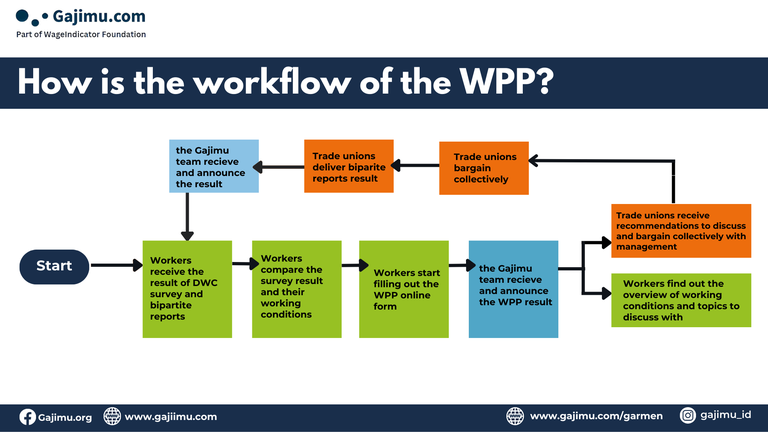- What is the WorkersPriorityPoll?
- What is the background of the WorkersPriorityPoll?
- What are the objectives and benefits of the WorkersPriorityPoll?
- What does the WorkersPriorityPoll include?
- Who can participate in the WorkersPriorityPoll?
- How does the WorkersPriorityPoll process work?
- How can labour unions utilise the WorkersPriorityPoll?
What is the Workers Priority Poll?
The WorkersPriorityPoll or WPP is a tool or an instrument for gathering workers' aspirations in a company regarding labour-related topics that are a priority for negotiation between labour union representatives and employers. This poll can facilitate data-driven collective bargaining to improve working conditions according to the workers' needs. As the name suggests, the WPP functions as a 'digital suggestion box', and the polling responses are anonymous, without disclosing the personal identities of the workers providing suggestions.
What is the background of the Workers Priority Poll?
Before engaging in negotiations with management, some labour unions in a company have already encouraged their members, who are employees in that company, to express their aspirations. However, such efforts have not been widely adopted by all labour unions. Furthermore, when the process of collecting aspirations is manual, it can be time-consuming to obtain the results.
The Makin Terang team also discovered a discrepancy between the results of the DecentWorkCheck survey and the collective bargaining data reports. For example, the top two compliance issues identified in TGSL (Textile, Garment, Shoes, and Leather) factories were job security and maternity leave. However, during the collective bargaining meetings conducted in TGSL factories, wages were the most frequently discussed topic. This discrepancy between the DecentWorkCheck survey and the collective bargaining reports must be bridged.
The Polling system also originated from evaluating the DecentWorkCheck survey, which assesses compliance with normative working conditions or conditions arising from existing labour laws and regulations. The polling allows workers to provide suggestions beyond normative matters, such as additional job facilities, periodic job training, improved wage scales, and more.
Extensive polling participants are believed to represent groups of workers who have been underrepresented thus far, such as female workers, workers with disabilities, young workers, elderly workers, and others.
What are the objectives and benefits of the Workers Priority Poll?
For workers, the WorkersPriorityPoll aims to voice their needs and aspirations in the workplace, select the most important labour-related topics, and have meaningful involvement in decision-making processes that affect their working conditions. The WPP can be beneficial for workers to effectively advocate for their rights, improve working conditions according to their needs, and feel valued and heard by their labour unions.
For labour unions, the WorkersPriorityPoll can be used to develop negotiation agendas that align with the aspirations and needs of their members. Additionally, it can enhance the credibility and legitimacy of labour unions, leading to various benefits, such as using polling results as strong and valid data for collective arguments and negotiations. This, in turn, can increase support and trust from workers and attract non-unionized workers to join labour unions due to their capacity to improve working conditions.
What does the Workers Priority Poll include?
Essentially, the WorkersPriorityPoll is designed to accommodate any worker's aspirations. For data collection, these aspirations are categorized into ten topics and 124 subtopics related to labour. Each topic consists of a different number of subtopics.
Here is a list of the ten topics covered in the WorkersPriorityPoll:
- Freedom of association
- Employment relations
- Working hours and rest time
- Wages
- Protection of female workers
- Occupational health and safety (OHS)
- Social security
- Worker facilities and welfare
- Termination of employment and regulations
- Complaint resolution
Who can participate in the Workers Priority Poll?
All workers in a company where the polling is conducted can participate in the WorkersPriorityPoll. However, to ensure workers' confidence in their choices, Gajimu.com recommends polling companies that have already completed the DecentWorkCheck survey and have monitored the implementation of collective bargaining.
How does the Workers Priority Poll process work?
Before participating, workers receive the results of the DecentWorkCheck survey and collective bargaining reports from the Gajimu team. They can then compare these survey results with their working conditions in the factory. Based on this analysis, workers can fill out the WorkersPriorityPoll form. The Gajimu team receives, processes, and shares the polling results with the workers and labour unions. Both labour unions and workers gain insight into the issues in the factories and the topics to be discussed in collective bargaining with management. Subsequently, labour unions engage in collective bargaining and report the outcomes. The Gajimu team receives, processes, and shares the collective bargaining reports with the labour unions and workers. This work process continues cyclically.
The WorkersPriorityPoll process is illustrated below, with colour-coded roles assigned to each involved party. The green box represents workers, the orange box represents labour unions, and the blue box represents the Gajimu team. The Gajimu team's role will be replaced by labour unions, allowing for the continuous and independent use of this polling tool.

How can labour unions utilise the Workers Priority Poll?
To support labour unions in effectively utilising the WorkersPriorityPoll, the Trade Union Rights Centre team has established a discussion and learning platform for workers called the "learning circle." This learning circle is intended for WorkersPriorityPoll respondents from various labour unions and those who are not yet members of labour unions. For respondents from labour unions, the learning circle serves as a forum for learning and discussion to maximize the use of the WorkersPriorityPoll in making collective bargaining more effective. Meanwhile, for workers in companies without labour unions, the learning circle can be utilised to understand the importance of labour unions and collective bargaining in improving working conditions.
